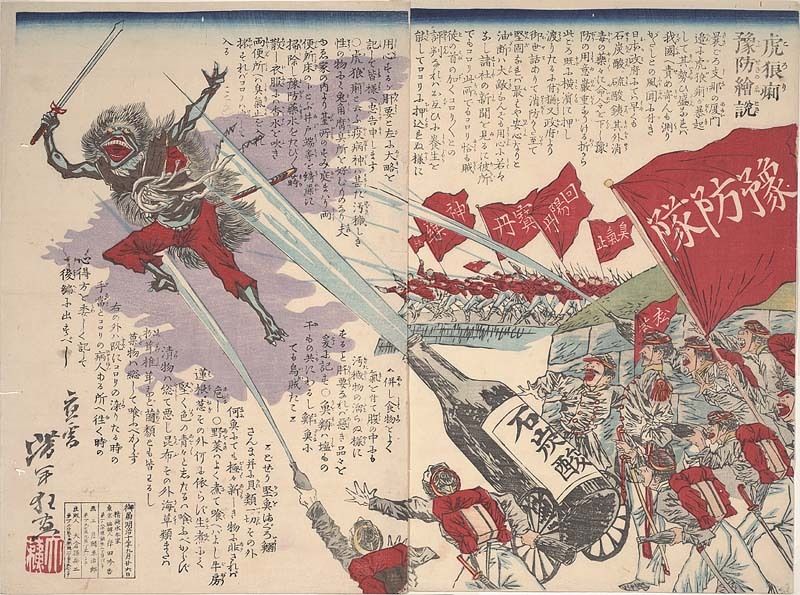Jul 29, 2020
Are we keeping our students and teachers safe?

19th century illustrated cholera prevention manual, University of California San Francisco
Are we doing this right? That's my biggest worry as the coronavirus pandemic continues to spread in the capital region, not far from where I teach in a private high school. Many of our students commute from Tokyo proper, and although the infection rates are lower in surrounding prefectures, a pandemic doesn't respect boundaries when people are taking mass transportation and working together. Here are my observations of what we are doing at one particular institution in the Kanto region.
School Bus Issues
Most of our students are dependent on a school bus to ferry them from the nearest train station to campus. On a good day, the lineup snakes around the bus rotary. Now, we ask our students to take distance, as our school bus drivers carefully count and limit the number of passengers to observe social distancing.
The result is even longer lineups and delays and stress for our students. While on the bus, students are supposed to remain silent. Senior high students are compliant, but exuberant junior high students lack the attention span and maturity to abide by the rule. Perhaps that 10-minute school bus ride poses the greatest risk for transmission of corona virus as it is near impossible to observe The Three Cs.
Masks and Shields
Before the state of emergency, our school administration procured masks and provided two boxes of 50 for each staff member. Later, we received face shields. The teachers are directed to wear either at all times. Most of us rely on the masks, but as the warm and humid weather continues, it becomes more and more uncomfortable to wear them. I worry that the discomfort means that we’re more likely to touch the surface of the mask, which reduces the effectiveness of wearing them.
Some teachers prefer the plastic face shields as they make it easier to talk and especially for English teachers, to provide clear communication and modeling of pronunciation. The downside is that with the shield on, voices sound tinny.
All students must wear masks, and we keep big boxes of spares in the staff room. Junior and senior high students to our relief are compliant with the rules.
The Three Cs
The Ministry of Health, Labor, and Welfare cautions people to avoid the Three Cs – closed spaces, crowded places, and close contact. But let’s be honest, a school environment violates these three prohibitions both in classrooms and after school activities. Our institution attempts to avoid the three risks by opening classroom doors even with the air conditioning running, requiring teachers to hand out materials individually, one by one, to students, and prohibits pair and group work.
Academics
The effect on academics is slowly becoming apparent and affects the students' morale. All I can say is that, though our students in junior high school appear enthusiastic about studies, benchmark tests, and club activities, I can’t say that they are reaching the same level of achievement as the previous year. Of course, the state of emergency and the closure of schools set them back academically. The students have on the whole rallied despite being deprived of months of instruction.
The students have great English comprehension and spelling skills (they received a lot of input and drilling under the state of emergency), but their penmanship and communication skills are poor this year.
It’s not like they don’t try. It’s just that the constraints the English teachers are compelled to work under are not conducive to providing the kind of support that would lead to good handwriting and speaking skills. The crucial first few weeks of instruction were delivered online, thwarting corrections of individual students’ work. In whole-class video conferences, the lessons were teacher-fronted, and students wrote short responses in chat windows, mostly in Japanese. They didn’t get into the habit of English interaction with their teachers.
Realities of the Pandemic
Every week in our staff meetings, the subtext is, be ready for closure. Fortunately, we've nearly finished the first term, and are nearly done with the assessment. We hope that we can finish the exam schedule and get our marks in.
However, we don't see the national or prefectural governments returning to a state of emergency any time soon even as reported infection rates are over 30,000. It's up to us average citizens and foreign residents to keep the pandemic from overwhelming resources and hospitals.
My hope is that our diligence will help our students and teachers remain healthy, their families safe, and that our young people emerge from junior high school with massive English vocabulary and excellent listening comprehension.



0 Comments